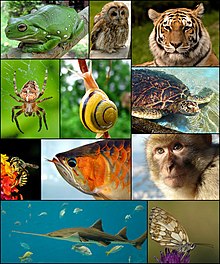Nephrozoa
| Nephrozoa | |
|---|---|

| |
| Diversity of nephrozoans | |
| Scientific classification | |
| Kingdom: | Animalia |
| Subkingdom: | Eumetazoa |
| Clade: | ParaHoxozoa |
| Clade: | Bilateria |
| Clade: | Nephrozoa et al. , 2002 |
| Phyla | |
| |
| Synonyms | |
|
Eubilateria Peter Ax, 1987 | |
Nephrozoa is a major clade of bilaterians, divided into the protostomes and the deuterostomes, containing almost all animal phyla and over a million extant species. Its sister clade is the Xenacoelomorpha. The Ambulacraria (conventionally deuterostomes) was formerly[dubious ] thought to be sister to the Xenacoelomorpha, forming the Xenambulacraria as basal Deuterostomes, or basal Bilateria invalidating Nephrozoa and Deuterostomes in earlier studies.[1][2][3] The coelom, the digestive tract and excretory organs, and nerve cords developed in the Nephrozoa.[4] It has been argued that, because protonephridia are only found in protostomes, they cannot be considered a synapomorphy of this group. This would make Nephrozoa an improper name, leaving Eubilateria as this clade's name.[5]
Chordates (which include all the vertebrates) are deuterostomes.[6] It seems very likely that the 555 million year old Kimberella was a protostome.[7][8] If so, this means that the protostome and deuterostome lineages must have split some time before Kimberella appeared — at least 558 million years ago, and hence well before the start of the Cambrian 541 million years ago.[6]
| Bilateria |
| ||||||||||||||||||||||||||||||
References[]
- ^ Philippe, Hervé; Poustka, Albert J.; Chiodin, Marta; Hoff, Katharina J.; Dessimoz, Christophe; Tomiczek, Bartlomiej; Schiffer, Philipp H.; et al. (2019). "Mitigating Anticipated Effects of Systematic Errors Supports Sister-Group Relationship between Xenacoelomorpha and Ambulacraria". Current Biology. 29 (11): 1818–1826.e6. doi:10.1016/j.cub.2019.04.009. hdl:21.11116/0000-0004-DC4B-1. ISSN 0960-9822. PMID 31104936. S2CID 155104811.
- ^ Marlétaz, Ferdinand (2019-06-17). "Zoology: Worming into the Origin of Bilaterians". Current Biology. 29 (12): R577–R579. doi:10.1016/j.cub.2019.05.006. ISSN 0960-9822. PMID 31211978.
- ^ Kapli, Paschalia; Telford, Maximilian J. (11 Dec 2020). "Topology-dependent asymmetry in systematic errors affects phylogenetic placement of Ctenophora and Xenacoelomorpha". Science Advances. 6 (10). doi:10.1126/sciadv.abc5162. Retrieved 17 December 2020.
- ^ Cannon, Johanna Taylor; Vellutini, Bruno Cossermelli; Smith, Julian; Ronquist, Fredrik; Jondelius, Ulf; Hejnol, Andreas (2016). "Xenacoelomorpha is the sister group to Nephrozoa". Nature. 530 (7588): 89–93. Bibcode:2016Natur.530...89C. doi:10.1038/nature16520. PMID 26842059. S2CID 205247296.
- ^ "Animal Evolution: Interrelationships of the Living Phyla. Third Edition. By Claus Nielsen. Oxford and New York: Oxford University Press ISBN: 978-0-19-960602-3 (hc); 978-0-19-960603-0 (pb). 2012". The Quarterly Review of Biology. 87 (3): 258. September 2012. doi:10.1086/666815. ISSN 0033-5770.
- ^ a b Erwin, Douglas H.; Eric H. Davidson (1 July 2002). "The last common bilaterian ancestor". Development. 129 (13): 3021–3032. PMID 12070079.
- ^ New data on Kimberella, the Vendian mollusc-like organism (White sea region, Russia): palaeoecological and evolutionary implications (2007), "Fedonkin, M.A.; Simonetta, A; Ivantsov, A.Y.", in Vickers-Rich, Patricia; Komarower, Patricia (eds.), The Rise and Fall of the Ediacaran Biota, Special publications, 286, London: Geological Society, pp. 157–179, doi:10.1144/SP286.12, ISBN 9781862392335, OCLC 156823511CS1 maint: uses authors parameter (link)
- ^ Butterfield, N.J. (December 2006). "Hooking some stem-group "worms": fossil lophotrochozoans in the Burgess Shale". BioEssays. 28 (12): 1161–6. doi:10.1002/bies.20507. PMID 17120226. S2CID 29130876.
Further reading[]
- Balavoine, G. (17 April 1998). "EVOLUTION: One or Three Cambrian Radiations?". Science. 280 (5362): 397–398. doi:10.1126/science.280.5362.397. ISSN 0036-8075. S2CID 84468701. Lay summary.
- Bourlat, S; Nielsen, C; Economou, A; Telford, M (October 2008). "Testing the new animal phylogeny: A phylum level molecular analysis of the animal kingdom". Molecular Phylogenetics and Evolution. 49 (1): 23–31. doi:10.1016/j.ympev.2008.07.008. ISSN 1055-7903. PMID 18692145.
- Jondelius, Ulf; Ruiz-Trillo, Inaki; Baguna, Jaume; Riutort, Marta (April 2002). "The Nemertodermatida are basal bilaterians and not members of the Platyhelminthes". Zoologica Scripta. 31 (2): 201–215. doi:10.1046/j.1463-6409.2002.00090.x. ISSN 0300-3256.
External links[]
 Data related to Nephrozoa at Wikispecies
Data related to Nephrozoa at Wikispecies
- Nephrozoa
- Bilaterians
- Ediacaran first appearances
- Zoology stubs
